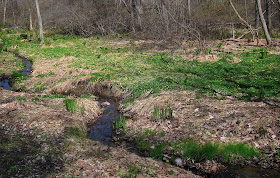Monday's walk was still very pleasant, though, with a warming sun and just a slight breeze to riffle the lake's blue water. This Egret also added to the beauty of the scene, with its elegant profile reflected in the calm water close to shore.
The dark pink of these Highbush Blueberry buds was beautifully set off by that radiant blue sky.
Aha! Here at last were masses of lovely wildflowers, carpeting a marshy area surrounding a little stream.
But my delight soon turned to dismay when I discovered those bright yellow blooms and glossy green leaves belonged to the terribly invasive alien plant, Lesser Celandine (Ranunculus ficaria var. bulbifera).
There's no denying that this is a beautiful plant, sought after by gardeners to spread its cheerful blooms over soggy areas in their gardens. Unfortunately, it does not stay confined to gardens but has migrated to many streamside banks and supplanted many native plants that once grew there. Whenever I find it growing along Saratoga County streams, I promptly pull it out.
Home again to Saratoga Springs. And the weather turned warm at last! I was happy when I visited Bog Meadow Nature Preserve today, to find our own native streamside beauties blooming abundantly. Is there any flower more gloriously bright than Marsh Marigold (Caltha palustris), with its blooms the color of sunshine, set among mounds of glossy green leaves? No other flower announces so vigorously that spring has finally arrived.
Well, Carolina Spring Beauty (Claytonia caroliniana) is also a definite announcer of spring, although it whispers, rather than blares that message, with its dainty size and delicate coloration. Hundreds of these pretty pink-striped blooms were carpeting parts of the Bog Meadow woods today.
Many of the fertile, spore-bearing stalks of Field Horsetail (Equisetum arvense) appear to have shed their spores, while others have not yet lifted their scales to allow the wind to carry the spores away. Once they have completed their role in reproduction, these fertile stalks will wither and completely disappear.
Meanwhile, the sterile stalks of Field Horsetail are growing taller and opening their chlorophyll-containing structures to sustain them throughout the summer until autumn frost.
Bog Meadow is also home to another species of horsetail, the Woodland Horsetail (Equisetum sylvaticum), distinguished by the multiple branching of its whorls. This species does not produce separate fertile stalks that disappear after spore dispersion, but rather produces a fertile cone that tops some of its branching stalks. This cone will fall off after spores are released, but the leafy stalk with continue to grow. Those big green pleated leaves behind the horsetail are those of False Hellebore (Veratrum viride), a Lily-family plant often mistaken for Skunk Cabbage.
I wish I knew the name of the understory tree that has put out these pretty leaves that appeared to float on the air like a flock of brightly colored birds. The bark was smooth and gray like American Hornbeam, but the finely serrated leaves were not sharply pleated. Note the large red bud scales. That should be a clue for folks more schooled in tree buds than I am. Anybody?












Lovely pictures as always! Just another few days to go here yet to catch up to you. I did see Marsh Marigolds in bud yesterday, but no blooms. Only things so far outside the garden are skunk cabbage and coltsfoot.
ReplyDeleteLove you posts, always inspiring me to look a little closer. The red leafed tree looks like a Black Cherry.
ReplyDeleteAmelanchier has leaves that come out like that, but usually at the same time as the blossoms.
ReplyDelete